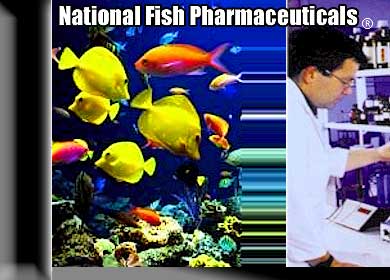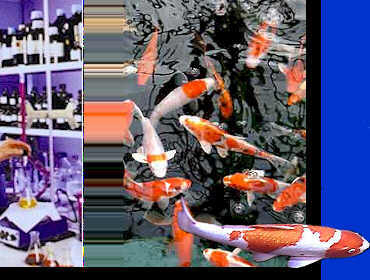| A). Small red to grayish nodules
protrude 1 to 2mm above the surface of the skin. In
advanced cases they can have a rough texture |
 |
Carp Pox (Herpesvirus Ciprini) |
 |
No suitable treatment known. This disease
is not fatal, but the growth of the fish may be retarded. |
| B). Fish display hemorrhages on the
gills, operculum (gill plate), in the mouth cavity and at the
bases of the fins. Internal organs will be affected. |
 |
V.H.S. Virus
(Viral Hemorrhagic Septicemia) |
 |
No suitable treatment known. Separate
affected fish. Sterilize equipment and maintain healthy
water quality. Do not overcrowd your fish. |
| C). The fish's gills are pale, the
stomach is distended. A thick mucoid substance trails out
of the anal vent. Some fish have loss of the equilibrium
and uncoordinated swimming. Ulcerations and septicemic
symptoms may accompany this virus. |
 |
Cause: Rhabdovirus Carpio.
Trade Name: S.V.C. Virus, Spring Viremia of
Carp, Infectious Dropsy |
 |
Heating the water to 86°F
for 7 days has shown to kill this virus. Secondary
infections may be treated with
Koi Fix®
-or-
Oxytetracycline + Oxolinic Acid
in the feed. Forma-Green may be used in the water if the
fish have ulcerations. |
| D). Fish may darken in color and become
lethargic. Excess slime coat is apparent. White
to yellow patches may be observed inside the gills. Secondary
bacterial infections may also be present, as well as internal
organ damage. |
 |
K.H.V. Virus
(Koi Herpes Virus)
Click Here for KHV
Treatment Info. |
 |
Heat the fish up to 86°F
for 7 days.
Do not treat the fish with anything during the heat treatment as
this will stress them out. After 7 days the secondary infections may be treated with
Koi Fix®
-or- Gentamycin Sulfate.
Heating the water is most important. |
| A little more about Koi and
viruses. 9 times out of 10, the cause of the disease is
due to a gram-negative bacterial infection from the following
bacteria: Aeromonas Salmonicida, Aeromonas Hydrophila,
Pseudomonas Fluorescens. Sometimes these bacteria
become resistant to traditional treatments, especially if they
are not used properly. People tend to say it is a "virus"
in these types of scenario's because the medications did not
work. Remember: If you are using antibiotics, rule of
thumb is: They must be used for a 10 day minimum treatment.
Water temperatures are also a big factor. The Koi will not
respond to treatments unless the water temperature is at least
65°F.
S.V.C. virus, is one that we see every year around
springtime. This particular virus will be unknown to the
hobbyist until the fish's immune system is weakened, and
secondary infections due to one of the bacteria listed above...
invades the fish. So in this case, you have two things to
deal with, a virus, and a bacterial disorder. S.V.C. virus
cannot survive temperatures above 83°F.
We suggest raising the temperature up to 86°F for 5-7 days, then
slowly cool the fish down by no more than 2°F per day until the
water temperature is around 80°F. Start the antibiotic
treatments at this temperature and continue to treat the fish
until all secondary infections have cleared (anywhere from 10-14
days).
Treating a viral infection can be a
problem especially if you have a very large pond and no way to
heat it. Many "newbies" to the hobby soon find out that it
can become very costly to purchase isolation tanks, or even
build a smaller isolation pond, so that you can medicate when
necessary. It is very unfortunate that people are not
informed of this by their retailer, and it is absolutely
necessary. Always try to avoid treating your main pond as
some of the medications will harm the nitrifying bacteria that
keep it cycled and ammonia free.
|

